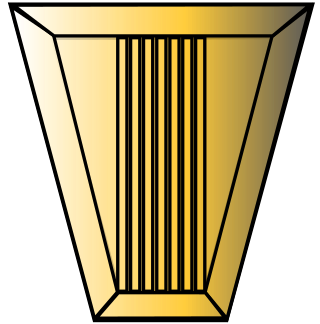Related Research Articles

The United States secretary of state (SecState) is a member of the executive branch of the federal government and the head of the Department of State. The office holder is the second-highest-ranking member of the president's Cabinet, after the Vice President, and ranks fourth in the presidential line of succession; first amongst cabinet secretaries.

The United States Foreign Service is the primary personnel system used by the diplomatic service of the United States federal government, under the aegis of the United States Department of State. It consists of over 13,000 professionals carrying out the foreign policy of the United States and aiding U.S. citizens abroad. Its current director general is Marcia Bernicat.
Diplomatic rank is a system of professional and social rank used in the world of diplomacy and international relations. A diplomat's rank determines many ceremonial details, such as the order of precedence at official processions, table seatings at state dinners, the person to whom diplomatic credentials should be presented, and the title by which the diplomat should be addressed.

The Cabinet of Singapore forms the executive branch of the Government of Singapore together with the President. It is led by the Prime Minister who is the head of government. The prime minister is a Member of Parliament (MP) appointed by the president who in the president's judgment is likely to command the confidence of the majority of the Members of Parliament (MPs). The other Ministers in the Cabinet are Members of Parliament appointed by the president acting in accordance with the advice of the prime minister. Ministers are prohibited from holding any office of profit and from actively engaging in any commercial enterprise.

The Senior Executive Service (SES) is a position classification in the civil service of the United States federal government equivalent to general officer or flag officer rank in the U.S. Armed Forces. It was created in 1979 when the Civil Service Reform Act of 1978 went into effect under President Jimmy Carter.
The General Schedule (GS) is the predominant pay scale within the United States civil service. The GS includes the majority of white collar personnel positions. As of September 2004, 71 percent of federal civilian employees were paid under the GS. The GG pay rates are identical to published GS pay rates.

A Foreign Service officer (FSO) is a commissioned member of the United States Foreign Service. Foreign Service officers formulate and implement the foreign policy of the United States. FSOs spend most of their careers overseas as members of U.S. embassies, consulates, and other diplomatic missions, though some receive assignments to serve at combatant commands, Congress, and educational institutions such as the various U.S. service academies.
Assistant secretary is a title borne by politicians or government officials in certain countries and territories, usually a junior ministers assigned to a specific cabinet minister.

The Indian Foreign Service (IFS) is a civil service under the All India Services. It is the diplomatic service and a central civil service of the Government of India under the Ministry of External Affairs. The Foreign Secretary is the head of the service. Vinay Mohan Kwatra is the 34th and the current Foreign Secretary.
The Federal Employees Pay Comparability Act of 1990 or FEPCA was an attempt to address the need for pay reform in the executive branch of the United States Government that became apparent in the 1980s as Federal civil service salaries fell behind those in the private sector. FEPCA provided guidelines to achieve pay comparability between Federal and non-Federal jobs. FEPCA was enacted as Section 529 of the Treasury, Postal Service and General Government Appropriations Act, 1991.
Pay grades are used by the eight uniformed services of the United States to determine wages and benefits based on the corresponding military rank of a member of the services. While different ranks may be used among the eight uniformed services, pay grades are uniform and equivalent between the services and can be used to quickly determine seniority among a group of members from different services. They are also essential when determining a member's entitlements such as basic pay and allowances.

The Federal Executive Council (FEC), also simply known as The Cabinet is the cabinet of ministers of the Federal Republic of Nigeria and is part of the executive branch of the Government of Nigeria. The council's role, as written in the Ministers' Statutory Powers and Duties Act, is to serve as an advisory body to the President of Nigeria, who serves as the FEC's chairman. Members of the cabinet are appointed and report to the President, who can dismiss them at will. The cabinet currently consists of 24 Federal Ministries, each responsible for some aspect of providing government services, as well as a number of parastatals (government-owned corporations).

Income tax in India is governed by Entry 82 of the Union List of the Seventh Schedule to the Constitution of India, empowering the central government to tax non-agricultural income; agricultural income is defined in Section 10(1) of the Income-tax Act, 1961. Income-tax law consists of the 1961 act, Income Tax Rules 1962, Notifications and Circulars issued by the Central Board of Direct Taxes (CBDT), annual Finance Acts, and judicial pronouncements by the Supreme and high courts.
The United States federal civil service is the civilian workforce of the United States federal government's departments and agencies. The federal civil service was established in 1871. U.S. state and local government entities often have comparable civil service systems that are modeled on the national system to varying degrees.

Members of the Scottish Parliament (MSPs) are entitled to a salary, and where applicable, expenses and allowances.
Executive Schedule is the system of salaries given to the highest-ranked appointed officials in the executive branch of the U.S. government. The president of the United States appoints individuals to these positions, most with the advice and consent of the United States Senate. They include members of the president's Cabinet, several top-ranking officials of each executive department, the directors of some of the more prominent departmental and independent agencies, and several members of the Executive Office of the President.
A-100 is the colloquial name given to the introductory/orientation training class for incoming Foreign Service Officers. These courses are taught in the Foreign Service Institute at the National Foreign Affairs Training Center in Arlington, Virginia. The purpose of the class is to provide orientation to the United States Department of State, information on embassy operation and foreign affairs, intelligence collection and dissemination, State Department computer systems, and the roles different categories of personnel perform in the conduct of diplomacy. It is the basic job-orientation course for the United States Foreign Service before diplomats branch off into different career tracks or geographic specialties.
The following tables present the ranks of the Malaysian Armed Forces.
According to the United States Office of Government Ethics, a political appointee is "any employee who is appointed by the President, the Vice President, or agency head". As of 2016, there were around 4,000 political appointment positions which an incoming administration needs to review, and fill or confirm, of which about 1,200 require Senate confirmation. The White House Presidential Personnel Office (PPO) is one of the offices most responsible for political appointees and for assessing candidates to work at or for the White House.
References
- Kopp, Harry W.; Charles A. Gillespie (2008). Career Diplomacy: Life and Work in the U.S. Foreign Service. Washington, D.C.: Georgetown University Press. ISBN 978-1-58901-219-6.
- McCaffree, Mary Jane (2002). Protocol: The Complete Handbook of Diplomatic, Official & Social Usage. Durban House Press. ISBN 978-1-930754-18-8.